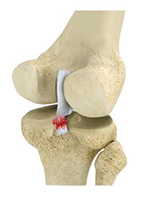PCL Reconstruction

Posterior Cruciate Ligament Anatomy
Posterior cruciate ligament (PCL), one of four major ligaments of the knee is situated at the back of the knee. It connects the thighbone (femur) to the shinbone (tibia). The PCL limits the backward motion of the shinbone.
What are PCL Injuries?
PCL injuries are very rare and are more difficult to detect than other knee ligament injuries. Cartilage injuries, bone bruises, and ligament injuries often occur in combination with PCL injuries. Injuries to the PCL can be graded as I, II or III depending on the severity of injury.
- In grade I, the ligament is mildly damaged and slightly stretched, but the knee joint is stable.
- In grade II, there is a partial tear of the ligament.
- In grade III, there is a complete tear of the ligament and the ligament is divided into two halves making the knee joint unstable.
Causes of PCL Injuries
The PCL is usually injured by a direct impact, such as in an automobile accident when the bent knee forcefully strikes the dashboard. In sports, it can occur when an athlete falls to the ground with a bent knee. Twisting injury or overextending the knee can cause the PCL to tear.
Symptoms of PCL Injuries
Patients with PCL injuries usually experience knee pain and swelling immediately after the injury. There may also be instability in the knee joint, knee stiffness that causes limping, and difficulty in walking.
Diagnosis of PCL Injuries
Diagnosis of a PCL tear is made based on your symptoms, medical history, and by performing a physical examination of the knee. Other diagnostic tests such as X-rays and MRI scan may be ordered. X-rays are useful to rule out avulsion fractures wherein the PCL tears off a piece of bone along with it. An MRI scan is done to help view the images of soft tissues better.
Treatment Options for PCL Injuries
Treatment options may include non-surgical and surgical treatment. Non-surgical treatment consists of rest, ice, compression, and elevation (RICE protocol); all assist in controlling pain and swelling. Physical therapy may be recommended to improve knee motion and strength. A knee brace may be needed to help immobilize your knee. Crutches may be recommended to protect your knee and avoid bearing weight on your leg.
PCL Reconstruction Procedure
Generally, surgery is considered in patients with a dislocated knee and multiple ligament injuries, including the PCL. Surgery involves reconstruction of the torn ligament using a tissue graft taken from another part of the body, or from a donor.
Surgery is usually carried out with the help of an arthroscope, using a few small incisions. The basic steps involved in PCL reconstruction are as follows:
- The surgeon inspects the knee and removes any remains of the native PCL, using an arthroscopic shaver. Care is taken to preserve the ligament of Wrisberg, if it is intact.
- The donor tendon is harvested from the patellar tendon or the semi tendinosis and gracilis tendon.
- The soft tissue around the femur is debrided to assist the insertion of the graft.
- A tunnel is created in the femur at the anatomic attachment site of the anterolateral bundle at the anteromedial wall of the intercondylar notch. This tunnel is drilled about 6-8 mm from the articular surface of medial femoral condyle.
- The tibial attachment site is also prepared by identifying the normal attachment of the PCL, at the bottom of the PCL facet.
- For placing the graft, a tibial tunnel is created to the anatomic insertion of the PCL on the tibia.
- Once the tunnels are drilled, the sharp edges and soft tissues around the exit site of the tunnel are smoothed, with a rasp.
- The tendon allograft is inserted in the femoral tunnel and fixed with a cannulated interference screw.
- The graft is made taut distally by removing any slack in the graft.
- The graft is then fixed to the tibia, with the help of staples.
- After fixation, normal posterior stability of the knee is assessed by employing the posterior drawer test.
- The incision is closed with sutures and covered with sterile dressings.
Postoperative Care following PCL Reconstruction
Patients are advised to maintain the knee in full extension, supported by a knee brace, for a period of 2 to 4 weeks. Patients should not bear any weight on the operated knee. Pillows or other supports are placed under the tibia, for the first two months after surgery, to prevent any posterior subluxation of the tibia.
Weight-bearing and rehabilitation is initiated after 8 weeks. Crutches are often required until you regain your normal strength.
Risks and Complications of PCL Reconstruction
Knee stiffness and residual instability are the most common complications associated with PCL reconstruction. The other possible complications include:
- Numbness
- Infection
- Blood clots (Deep vein thrombosis)
- Nerve and blood vessel damage
- Failure of the graft
- Loosening of the graft
- Decreased range of motion
